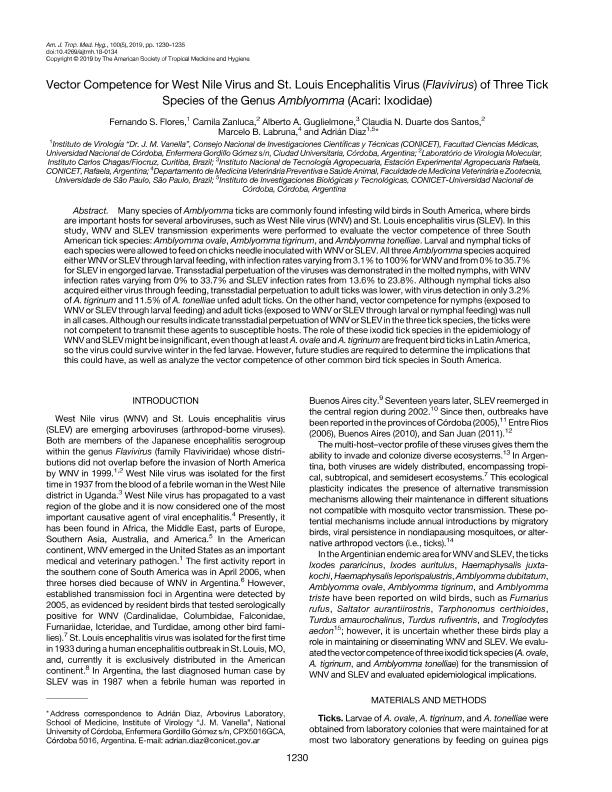Mostrar el registro sencillo del ítem
dc.contributor.author
Flores, Fernando Sebastián

dc.contributor.author
Zanluca, Camila
dc.contributor.author
Guglielmone, Alberto Alejandro

dc.contributor.author
Duarte dos Santos, Claudia N.
dc.contributor.author
Labruna, Marcelo B.
dc.contributor.author
Diaz, Luis Adrian

dc.date.available
2020-01-15T13:29:22Z
dc.date.issued
2019-05
dc.identifier.citation
Flores, Fernando Sebastián; Zanluca, Camila; Guglielmone, Alberto Alejandro; Duarte dos Santos, Claudia N.; Labruna, Marcelo B.; et al.; Vector competence for West Nile virus and St. Louis encephalitis virus (flavivirus) of three tick species of the genus Amblyomma (Acari: Ixodidae); American Society of Tropical Medicine and Hygiene; American Journal of Tropical Medicine and Hygiene; 100; 5; 5-2019; 1230-1235
dc.identifier.issn
0002-9637
dc.identifier.uri
http://hdl.handle.net/11336/94726
dc.description.abstract
Many species of Amblyomma ticks are commonly found infesting wild birds in South America, where birds are important hosts for several arboviruses, such as West Nile virus (WNV) and St. Louis encephalitis virus (SLEV). In this study, WNV and SLEV transmission experiments were performed to evaluate the vector competence of three South American tick species: Amblyomma ovale, Amblyomma tigrinum, and Amblyomma tonelliae. Larval and nymphal ticks of each species were allowed to feed on chicks needle inoculated with WNV or SLEV. All three Amblyomma species acquired either WNV or SLEV through larval feeding, with infection rates varying from 3.1% to 100% for WNV and from 0% to 35.7% for SLEV in engorged larvae. Transstadial perpetuation of the viruses was demonstrated in the molted nymphs, with WNV infection rates varying from 0% to 33.7% and SLEV infection rates from 13.6% to 23.8%. Although nymphal ticks also acquired either virus through feeding, transstadial perpetuation to adult ticks was lower, with virus detection in only 3.2% of A. tigrinum and 11.5% of A. tonelliae unfed adult ticks. On the other hand, vector competence for nymphs (exposed to WNV or SLEV through larval feeding) and adult ticks (exposed to WNV or SLEV through larval or nymphal feeding) was null in all cases. Although our results indicate transstadial perpetuation of WNV or SLEV in the three tick species, the ticks were not competent to transmit these agents to susceptible hosts. The role of these ixodid tick species in the epidemiology of WNV and SLEV might be insignificant, even though at least A. ovale and A. tigrinum are frequent bird ticks in Latin America, so the virus could survive winter in the fed larvae. However, future studies are required to determine the implications that this could have, as well as analyze the vector competence of other common bird tick species in South America.
dc.format
application/pdf
dc.language.iso
eng
dc.publisher
American Society of Tropical Medicine and Hygiene

dc.rights
info:eu-repo/semantics/embargoedAccess
dc.rights.uri
https://creativecommons.org/licenses/by-nc-sa/2.5/ar/
dc.subject
WEST NILE VIRUS
dc.subject
ST. LOUIS ENCEPHALITIS VIRUS
dc.subject
AMBLYOMMA TICKS
dc.subject
VECTOR COMPETENCE
dc.subject.classification
Virología

dc.subject.classification
Ciencias Biológicas

dc.subject.classification
CIENCIAS NATURALES Y EXACTAS

dc.title
Vector competence for West Nile virus and St. Louis encephalitis virus (flavivirus) of three tick species of the genus Amblyomma (Acari: Ixodidae)
dc.type
info:eu-repo/semantics/article
dc.type
info:ar-repo/semantics/artículo
dc.type
info:eu-repo/semantics/publishedVersion
dc.date.updated
2020-01-13T14:39:50Z
dc.journal.volume
100
dc.journal.number
5
dc.journal.pagination
1230-1235
dc.journal.pais
Estados Unidos

dc.journal.ciudad
Stanford
dc.description.fil
Fil: Flores, Fernando Sebastián. Universidad Nacional de Córdoba. Facultad de Medicina; Argentina
dc.description.fil
Fil: Zanluca, Camila. Instituto Carlos Chagas, Curitiba;
dc.description.fil
Fil: Guglielmone, Alberto Alejandro. Instituto Nacional de Tecnología Agropecuaria Eea, Rafaela; Argentina
dc.description.fil
Fil: Duarte dos Santos, Claudia N.. Instituto Carlos Chagas, Curitiba;
dc.description.fil
Fil: Labruna, Marcelo B.. Universidade de Sao Paulo; Brasil
dc.description.fil
Fil: Diaz, Luis Adrian. Universidad Nacional de Córdoba. Facultad de Medicina; Argentina. Universidad Nacional de Córdoba; Argentina
dc.journal.title
American Journal of Tropical Medicine and Hygiene

dc.rights.embargoDate
2020-05-31
dc.relation.alternativeid
info:eu-repo/semantics/altIdentifier/url/http://www.ajtmh.org/content/journals/10.4269/ajtmh.18-0134
dc.relation.alternativeid
info:eu-repo/semantics/altIdentifier/doi/http://dx.doi.org/10.4269/ajtmh.18-0134
Archivos asociados
